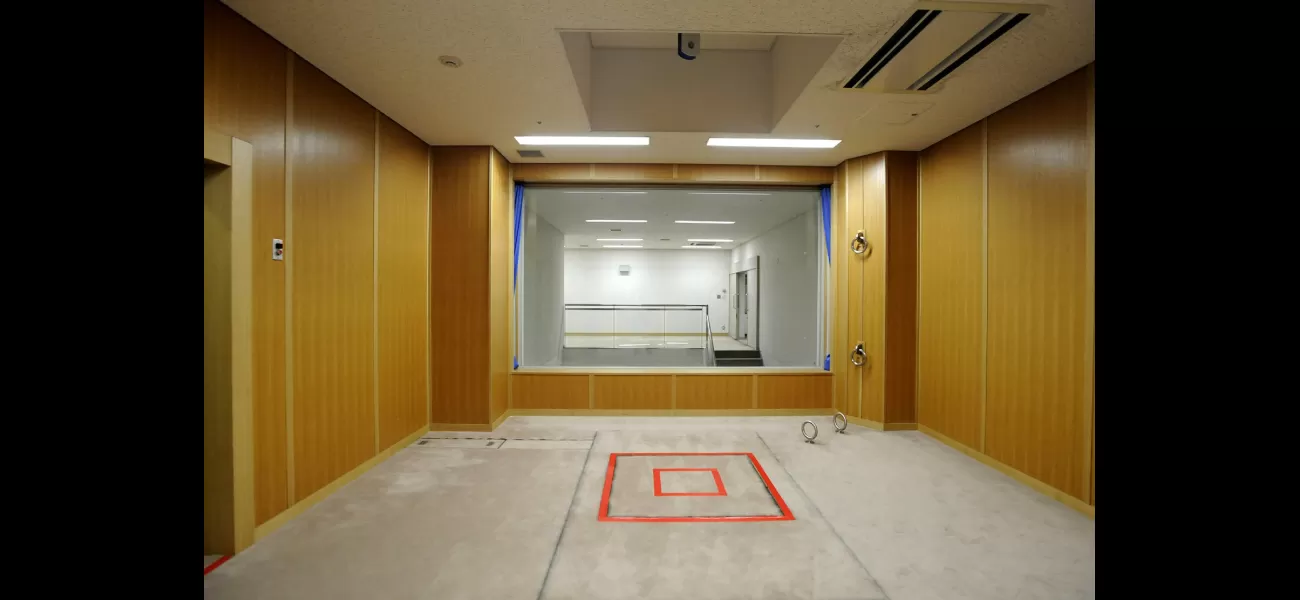In Japan's hidden death chambers, the most heinous criminals are put to death.
Japan's most dangerous criminals are executed in a top-secret room in a plain office building.
March 16th 2024.

In Japan, the death penalty is a highly secretive and controversial practice that has recently come into the spotlight. Fans of true crime have been granted a rare opportunity to see inside one of the few remaining execution chambers in the country, where the most heinous criminals are put to death. The Tokyo Detention House, located in Katsushika City, may appear to be a normal office building from the outside, but deep within its walls lies a morbid chamber where executions take place.
Upon entering the nondescript building, surrounded by a low wire fence, death row inmates are led to a stark, empty room and made to stand on a red square in the center. As they face their final moments, they pass by a small gold statue of Kannon, the Buddhist goddess of mercy. The room itself is a sterile, wood-paneled space with garish blue curtains, giving off an eerie and unsettling vibe.
Standing before a viewing platform in a separate room, the prisoners are executed by hanging. Medical professionals then confirm their death and perform a final, emotionless act of wiping down the body. The condemned are often not informed of their fate until just hours before their execution, leaving their families and lawyers in the dark until after it has taken place. Witnesses who have seen the hangings have described the horror of watching the officers pull the levers, dropping the blindfolded and hooded prisoners through a hatch into a chamber below.
Japan, along with the United States, is one of the only remaining G7 nations to still carry out the death penalty. According to the Death Penalty Information Centre, there were no executions in Japan last year, but three new death sentences were imposed. However, there are concerns that executions may be making a comeback, as seen with the recent sentencing of 21-year-old Yuki Endo in January 2024. Endo was convicted of murdering the parents of a girl who rejected him, making him the first person in Japan to receive the death penalty for a crime committed between the ages of 18 and 19.
The most recent execution at Tokyo Detention House was of Tomohiro Kato in 2022. Kato had killed seven people in 2008 by driving a truck into a crowd at the Akihabara shopping district. The secretive nature of Japan's executions raises questions about why they are kept under such tight wraps. According to the Death Penalty Information Centre, Japan's death penalty law requires "utmost secrecy." This means that convicts are typically only informed of their execution on the morning it takes place. Even their families are not always notified, despite this being a supposed requirement.
Lawyer Yoshikuni Noguchi, who once witnessed an execution, described the process in detail. After being informed of their fate, the prisoner is moved to a special room where they are monitored by security officers. The execution itself is carried out by a single pull of a lever, causing the body to drop through a hatch in the floor. Lawyer Noguchi was tasked with grabbing the rope to stop the body from shaking, an experience that deeply impacted him and led to his resignation from his role as a prison officer.
One of the most notorious prisoners executed at Tokyo Detention House was cult leader Shoko Asahara, real name Chizuo Matsumoto. Asahara founded the Aum Shinrikyo cult in 1984, attracting loyal followers into his bizarre ideology and rituals. However, behind the scenes, the cult was stockpiling weapons. In 1995, Asahara and his followers released sarin nerve gas into the Tokyo subway, killing 13 people. He was eventually convicted of multiple murders and other crimes, and after failed appeals, was hanged in 2018 along with six other cult members.
Critics of Japan's death penalty, including organizations like Amnesty International, argue that it is a violation of human rights, irreversible, and can lead to mistakes. They also claim that it does little to deter crime and is used in countries with problematic human rights records. Currently, Japan has 106 inmates on death row, according to the Death Penalty Information Centre. Across the world, 55 countries still have the death penalty, but 23 of those have not carried out an execution in the past 10 years. The debate over the use of capital punishment continues, with strong opinions on both sides.
Upon entering the nondescript building, surrounded by a low wire fence, death row inmates are led to a stark, empty room and made to stand on a red square in the center. As they face their final moments, they pass by a small gold statue of Kannon, the Buddhist goddess of mercy. The room itself is a sterile, wood-paneled space with garish blue curtains, giving off an eerie and unsettling vibe.
Standing before a viewing platform in a separate room, the prisoners are executed by hanging. Medical professionals then confirm their death and perform a final, emotionless act of wiping down the body. The condemned are often not informed of their fate until just hours before their execution, leaving their families and lawyers in the dark until after it has taken place. Witnesses who have seen the hangings have described the horror of watching the officers pull the levers, dropping the blindfolded and hooded prisoners through a hatch into a chamber below.
Japan, along with the United States, is one of the only remaining G7 nations to still carry out the death penalty. According to the Death Penalty Information Centre, there were no executions in Japan last year, but three new death sentences were imposed. However, there are concerns that executions may be making a comeback, as seen with the recent sentencing of 21-year-old Yuki Endo in January 2024. Endo was convicted of murdering the parents of a girl who rejected him, making him the first person in Japan to receive the death penalty for a crime committed between the ages of 18 and 19.
The most recent execution at Tokyo Detention House was of Tomohiro Kato in 2022. Kato had killed seven people in 2008 by driving a truck into a crowd at the Akihabara shopping district. The secretive nature of Japan's executions raises questions about why they are kept under such tight wraps. According to the Death Penalty Information Centre, Japan's death penalty law requires "utmost secrecy." This means that convicts are typically only informed of their execution on the morning it takes place. Even their families are not always notified, despite this being a supposed requirement.
Lawyer Yoshikuni Noguchi, who once witnessed an execution, described the process in detail. After being informed of their fate, the prisoner is moved to a special room where they are monitored by security officers. The execution itself is carried out by a single pull of a lever, causing the body to drop through a hatch in the floor. Lawyer Noguchi was tasked with grabbing the rope to stop the body from shaking, an experience that deeply impacted him and led to his resignation from his role as a prison officer.
One of the most notorious prisoners executed at Tokyo Detention House was cult leader Shoko Asahara, real name Chizuo Matsumoto. Asahara founded the Aum Shinrikyo cult in 1984, attracting loyal followers into his bizarre ideology and rituals. However, behind the scenes, the cult was stockpiling weapons. In 1995, Asahara and his followers released sarin nerve gas into the Tokyo subway, killing 13 people. He was eventually convicted of multiple murders and other crimes, and after failed appeals, was hanged in 2018 along with six other cult members.
Critics of Japan's death penalty, including organizations like Amnesty International, argue that it is a violation of human rights, irreversible, and can lead to mistakes. They also claim that it does little to deter crime and is used in countries with problematic human rights records. Currently, Japan has 106 inmates on death row, according to the Death Penalty Information Centre. Across the world, 55 countries still have the death penalty, but 23 of those have not carried out an execution in the past 10 years. The debate over the use of capital punishment continues, with strong opinions on both sides.
[This article has been trending online recently and has been generated with AI. Your feed is customized.]
[Generative AI is experimental.]
0
0
Submit Comment





